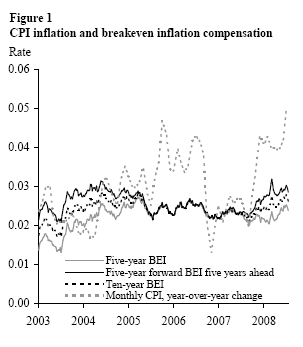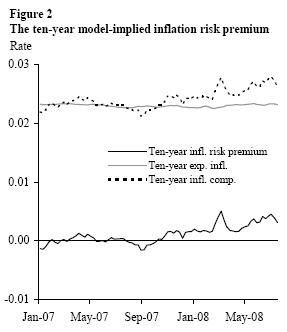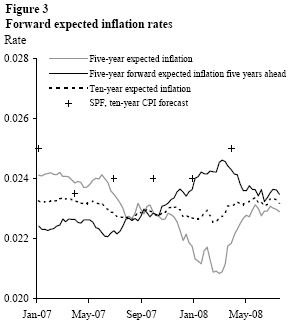The mandate of the Federal Reserve in carrying out monetary policy is to pursue price stability and maximum employment; while not formally defined for U.S. monetary policy, price stability generally is assumed to imply a “low” and predictable rate of inflation over a period of time. One way to gauge the success of monetary policy in meeting the mandate regarding price stability is to look at expectations of inflation, which, as studies have shown, influence future inflation rates.
The mandate of the Federal Reserve in carrying out monetary policy is to pursue price stability and maximum employment; while not formally defined for U.S. monetary policy, price stability generally is assumed to imply a “low” and predictable rate of inflation over a period of time. One way to gauge the success of monetary policy in meeting the mandate regarding price stability is to look at expectations of inflation, which, as studies have shown, influence future inflation rates. If monetary policy is successful at keeping expectations well-anchored by maintaining credibility in its commitment to price stability, then, for example, financial market participants would tend to “look through” rises in inflation and not radically change expectations about the rate of inflation over the longer run. Given the elevated rate of overall inflation over the past year, a highly pertinent issue is whether market participants are “looking through” the recent numbers on inflation and still see Federal Reserve policy as being consistent with longer-run price stability.
To address that issue, in this Economic Letter I use data on nominal and real Treasury yields to extract the market-implied expected inflation and study its behavior since the beginning of 2007. In particular, I use a model of the term structure of interest rates that allows for a decomposition of the compensation for inflation in nominal Treasury yields into compensation for inflation risk and compensation for expected inflation. The analysis indicates that long-run inflation expectations have remained relatively stable, while the measures of risk compensation have been more variable.
Nominal yields are interest rates earned on bonds where the notional principal is a fixed dollar amount. If we abstract from liquidity effects, three main factors determine the level of nominal yields. First, there is the real yield which bond investors require for postponing consumption. Second, there is compensation for the expected inflation over the life of the bond. Finally, nominal yields contain a risk compensation for unexpected variation in either of the above two components.
The difference between nominal and real yields of the same maturity is referred to as the breakeven inflation rate (BEI). For the analysis for this Letter, the BEI is viewed as the compensation required by investors in nominal bonds for being exposed to inflation and uncertainty about inflation (inflation risk).
For the U.S. (and certain other countries) high-frequency and up-to-date readings on BEI rates can be extracted from comparisons of the array of yields on Treasury inflation-protected securities (TIPS) and the nominal yields on other comparable Treasury securities. The payoff for a TIPS is adjusted according to the change in the nonseasonally adjusted U.S. consumer price index (CPI). Thus, the quoted interest rate on these bonds is measured relative to a fixed consumption basket, and the bond investor is compensated for inflation by adjusting both the principal and the coupon payments by the increase in the CPI since the date of issuance.
Analyses using data on TIPS and other Treasury securities have been greatly facilitated recently by the Board of Governors’ release of two databases, one containing nominal zero-coupon yields derived from fixed-rate Treasury bonds, the other containing real zero-coupon yields derived from TIPS bonds. A zero-coupon bond is a bond that does not have any coupon payments. Rather, it is sold at a discount to the notional or face value of a security. The only payment is an amount equal to the face value of the bond at maturity. For that reason, the yield on such a bond (referred to as the zero-coupon yield) is a well-defined concept that relates only to the maturity date of the bond. In contrast, the computation of a yield to maturity for a coupon-paying bond depends on the rate at which the coupons are reinvested. Using zero-coupon bond yields, then, has the advantage of allowing us to compare nominal and real yields with the same maturity in a consistent manner. The details of the databases as well as their content are publicly available at the web pages of the supporting working papers, Gürkaynak, Sack, and Wright (2006, 2008).
Gürkaynak et al. (2006) extract nominal zero-coupon bond yields for the entire maturity range trading in the Treasury bond market based on the prices of a wide range of regular Treasury coupon bonds. The data are daily starting in June 1961. I limit my focus to eight maturities ranging from three months to ten years observed at a weekly frequency over the period from January 6, 1995, to July 18, 2008.
The real yields used in the analysis are obtained from the prices on TIPS. For the period from the beginning of 1999 to the present, Gürkaynak et al. (2008) extract a real zero-coupon yield curve on a daily basis using all outstanding TIPS bonds.
The Treasury Department initiated its TIPS bond issuance in January 1997. In the first years, liquidity in the TIPS bonds was weak and well below that of regular Treasury bonds. However, since 2003 its liquidity has been close to that of regular Treasury bonds; therefore, I limit the sample of TIPS yields to the period from January 3, 2003, to July 18, 2008, and focus on the six maturities from five to ten years observed at a weekly frequency. The fact that the sample period for the real yields is shorter than that for the nominal yields does not pose a problem as it is easily handled by the Kalman filter used in the estimation below.
 Figure 1 illustrates the time series of the zero-coupon five- and ten-year BEI as well as the five-year forward BEI five years ahead that can be calculated from the five- and ten-year BEIs. Figure 1 also illustrates the year-over-year change in the monthly CPI since the beginning of 2003. Note that the CPI has been quite volatile over this period, with the rise in the year-over-year change in the monthly CPI since the fall of 2007 clearly visible. Also evident are the increases in the three measures of BEI–the next five years, five-year forward five years ahead, and the next ten years.
Figure 1 illustrates the time series of the zero-coupon five- and ten-year BEI as well as the five-year forward BEI five years ahead that can be calculated from the five- and ten-year BEIs. Figure 1 also illustrates the year-over-year change in the monthly CPI since the beginning of 2003. Note that the CPI has been quite volatile over this period, with the rise in the year-over-year change in the monthly CPI since the fall of 2007 clearly visible. Also evident are the increases in the three measures of BEI–the next five years, five-year forward five years ahead, and the next ten years.
The longer-horizon BEI measures are commonly assumed to reflect longer-term fundamentals affecting inflation expectations. This is especially true for the five-year forward measure five years ahead, which is the BEI implied for the period from six to ten years ahead. The increases in the longer-horizon BEIs, then, naturally raise concerns about whether bond investor’s long-run inflation expectations have started to shift upwards. However, as explained in Kwan (2005), the interpretation of the variation in the breakeven inflation is complicated by the fact that such variation can reflect changes not only in inflation expectations but also in the risk compensation investors require to be exposed to the inflation risk inherent in nominal Treasury bonds. To address that problem we need a dynamic model of nominal and real yields that will allow us to separate BEI into these two separate components.
A joint model of nominal and real bond yields
I use weekly data on nominal and real Treasury bond yields for the maturities noted above in a dynamic model of the term structure of interest rates with four factors. The four factors are known as “latent” factors, because they are not directly observable but can be gleaned from the patterns identified in the underlying data; in particular, the features of the term structure of interest rates are captured by the general level of rates, the slope of the yield curve and the curvature (shape) of the yield curve. For this analysis, then, the four factors estimated by the model can be interpreted as corresponding to separate level effects for the nominal and real yields in addition to a slope and a curvature effect that are shared by the nominal and real yields (for details, see Christensen, Diebold, and Rudebusch 2007). Finally, a simple arbitrage argument allows me to identify the model-implied inflation process, and the difference between the observable BEI and the model-implied expected inflation is referred to as the “inflation risk premium.”
 The decomposition of the ten-year BEI rate into the expected inflation and the inflation risk premiums derived from the model is shown in Figure 2. The figure shows that the ten-year inflation risk premium is small in absolute size (less than 25 basis points most of the time) and at times negative. However, central to this Letter, the model results indicate that the ten-year inflation expectations have been relatively stable. That is, most of the recent rise in the ten-year BEI rate has been due to an increase in the compensation for inflation risk.
The decomposition of the ten-year BEI rate into the expected inflation and the inflation risk premiums derived from the model is shown in Figure 2. The figure shows that the ten-year inflation risk premium is small in absolute size (less than 25 basis points most of the time) and at times negative. However, central to this Letter, the model results indicate that the ten-year inflation expectations have been relatively stable. That is, most of the recent rise in the ten-year BEI rate has been due to an increase in the compensation for inflation risk.
As indicated earlier, the five-year forward BEI five years ahead is commonly viewed as reflecting effects of longer-run fundamentals, in particular monetary policy. Figure 3 illustrates the estimates of longer-horizon expected inflation along with the five- and ten-year horizon estimates since the beginning of 2007. The model estimates of longer-run inflation did move up some in late 2007 and early 2008, and are not as stable as the estimates for the ten-year expectations. Still, less than 25% of the 0.5 percentage point increase in the longer-run BEI since the end of June 2007 observed in Figure 1 is due to an increase in the longer-horizon expected inflation, with the remaining 75% explained by a rise in the inflation risk premium. Furthermore, the stability of the 10-year expected inflation is in line with the relatively stable behavior over time of the ten-year inflation expectations reported in the quarterly Survey of Professional Forecasters (SPF), also  shown in Figure 3.
shown in Figure 3.
In this Economic Letter, I have analyzed nominal and real Treasury bond yields jointly in order to extract information about bond investors’ inflation expectations. I find that measures of longer-term inflation expectations are relatively stable, with most of the variation in BEI reflecting movements in compensation for inflation risk. With regard to recent developments, despite the weakening of the dollar and the significant rise in oil and other commodity prices, longer-run inflation expectations so far appear to be relatively well anchored. The estimate of the five-year forward expected inflation five years ahead did drift up late last year and earlier this year but has retraced much of that rise in recent weeks. The analysis also reveals that the recent run-up in the long-run BEI since the fall of 2007 is driven primarily by an increase in inflation risk premia rather than an increase in long-run expected inflation.
Jens Christensen
Economist
[URLs accessed August 2008.]
Christensen, Jens H. E., Francis X. Diebold, and Glenn D. Rudebusch. 2007. “The Affine Arbitrage-Free Class of Nelson-Siegel Term Structure Models.” FRB San Francisco Working Paper 2007-20.
Gürkaynak, Refet S., Brian Sack, and Jonathan H. Wright. 2006. “The U.S. Treasury Yield Curve: 1961 to the Present.” Federal Reserve Board, Finance and Economics Discussion Series 2006-28 (October).
Gürkaynak, Refet S., Brian Sack, and Jonathan H. Wright. 2008. “The TIPS Yield Curve and Inflation Compensation.” Federal Reserve Board, Finance and Economics Discussion Series 2008-05 (February).
Kwan, Simon. 2005. “Inflation Expectations: How the Market Speaks.” FRBSF Economic Letter 2005-25 (October 3).
Opinions expressed in FRBSF Economic Letter do not necessarily reflect the views of the management of the Federal Reserve Bank of San Francisco or of the Board of Governors of the Federal Reserve System. This publication is edited by Anita Todd and Karen Barnes. Permission to reprint portions of articles or whole articles must be obtained in writing. Please send editorial comments and requests for reprint permission to research.library@sf.frb.org